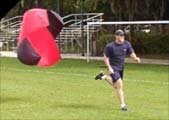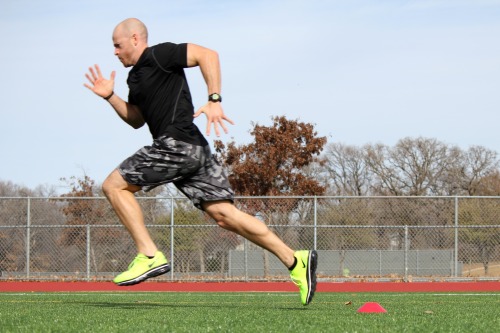To be a complete ballplayer you need to constantly work on many things.
To be sure... one of these things is explosive "SPEED"!
Everyone can train to be more exlplosive, quicker, and run faster. Everyone!
The following is an article by Mike Gough. Mike is president of www.procombinetraining.com.
Mike is currently training top NCAA football players for the NFL draft combines.
He has previously held the position of Strength and Conditioning Coach with the Toronto Raptors and Cleveland Indians.
Speed training can be broken up into different components.
Resisted, overspeed, form running, acceleration and sport-specific speed.
All these training modalities can be used in a training program to increase an athlete's speed.
Depending on the athlete's limitations, we can select different types to enhance acceleration, top end speed and sport-specific speed.
Resisted Speed Training
 Can include the use of a resisted device to overload the running stride
of the athletes, such as the OPS Parachute, OPS Super Sprint Cords and
Speed Trainers, etc.
Can include the use of a resisted device to overload the running stride
of the athletes, such as the OPS Parachute, OPS Super Sprint Cords and
Speed Trainers, etc. Depending on the device selected, different aspects of speed development can be targeted.
An example is the OPS parachute, since the chute does not open and provide resistance until the 5-10 yard mark, it targets top end speed and not acceleration.
Where the OPS sprint cords provide resistance from the first stride forward the target acceleration.
When adding resistance to the running stride it should not compromise the running technique.
Overspeed Training
Includes any type of exercise that forces the body to move itself faster than normal.
The use of sprint cord pulls (right) are great to improve acceleration from the start position.
Another example of overspeed training is running on a slight 1-3 degree decline.
With this type of training are teaching the body to move at high speeds.
Form Running
Includes fundamental movements that mimic the running stride.
They can be used as great warm-up drills before a speed workout.
Running technique is critical to speed development. If technique is poor, speed will not be enhanced.
Form running includes A's, B's, Butt Kicks, Skips, Arm Swings etc.
When speed training remember that the key is quality not quantity.
Full recovery is essential to increase speed. Keep the distances specific to the sport or goal (40 yards for example).
Program
This type of speed and power training should be performed during the off-season.
Speed and power training should be completed 3 times per week in addition to a comprehensive strength program.
When training to improve the 40-yard dash time, include all aspects of speed training: first refine technical aspects of your running stride, work on acceleration, then top end speed.
The power training should complement the speed work with Plyometrics and Olympic lifting.
This will develop the explosiveness need for improved acceleration and a lower forty yard time.
About The Author
Mike Gough BSc, CSCS, CFC is president of www.procombinetraining.com.
Mike is currently training top NCAA football players for the NFL draft combines.
He has previously held the position of Strength and Conditioning Coach with the Toronto Raptors and Cleveland Indians.
He can be reached for consultation by e-mail at mikegough@procombinetraining.com
It's FREE!
baseballtrainingmagazine.blogspot.com
facebook.com/baseballtrainingmagazine



No comments:
Post a Comment